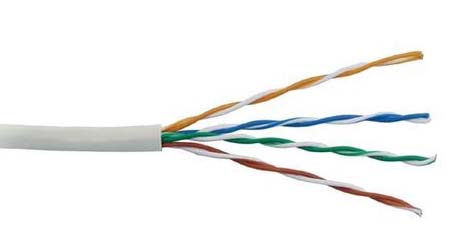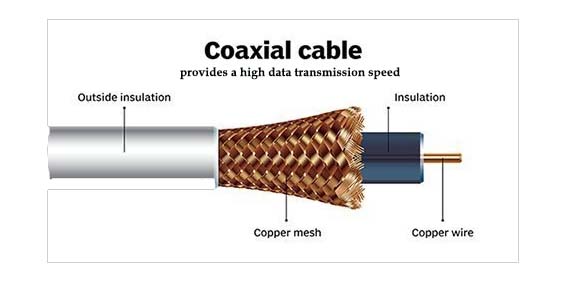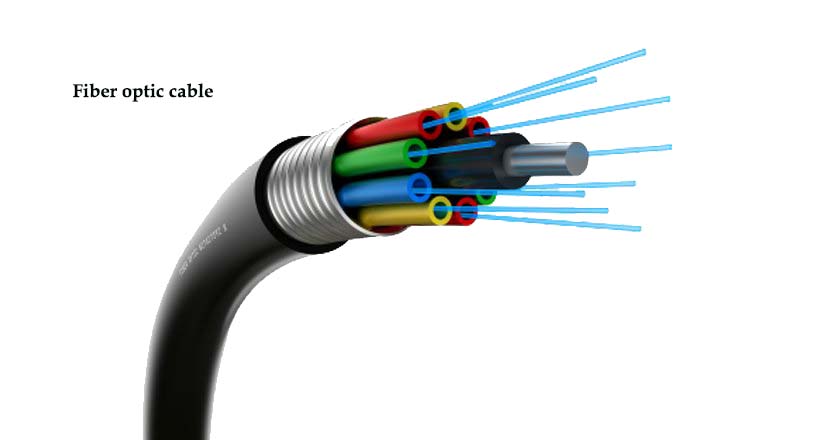Table of Contents
Guided Media
The cables that are substantial or have a physical existence and are confined by physical geography are known as guided media. Twisted pair cable, coaxial cable, and fibre optical cable are common bound transmission media. Each has its own set of features, such as transmission speed, noise effect, physical look, cost, and so on.
It is defined as the physical medium through which the signals are transmitted. It is also known as Bounded media.
Types Of Guided media:
Twisted pair:
Twisted pair is a type of physical media made up of two cables that are twisted together. When compared to other transmission media, a twisted pair cable is inexpensive. The twisted pair cable is simple to install and is light in weight. The frequency range for twisted pair cable is from 0 to 3.5KHz.

Two insulated copper wires are twisted together in a spiral pattern to form a twisted pair. The amount of turns per foot determines how much noise interference is reduced. Noise interference is reduced by increasing the number of turns per foot.
Types of Twisted pair:
- Unshielded Twisted Pair
- Shielded Twisted Pair
Unshielded Twisted Pair:
An unshielded twisted pair is widely used in telecommunication. Following are the categories of the unshielded twisted pair cable:
Category 1: Category 1 is used for telephone lines that have low-speed data.
Category 2: It can support up to 4Mbps.
Category 3: It can support up to 16Mbps.
Category 4: It can support up to 20Mbps. Therefore, it can be used for long-distance communication.
Category 5: It can support up to 200Mbps.
Advantages Of Unshielded Twisted Pair:
- It is inexpensive.
- The unshielded twisted pair is simple to install.
- It can be used to connect to a high-speed LAN.
Disadvantage:
Due to attenuation, this wire can only be utilized for short distances.
Shielded Twisted Pair
A shielded twisted pair cable is made up of a mesh that surrounds the wire and allows for a better transmission rate.
Characteristics Of Shielded Twisted Pair:
- The shielded twisted pair cable costs neither too much nor too little.
- STP is quite simple to set up.
- When compared to an unshielded twisted pair cable, it has a larger capacity.
- Its attenuation is higher.
- It is insulated, allowing for faster data transfer.
Disadvantages
- When compared to UTP and coaxial cable, it is more expensive.
- It has a higher rate of attenuation.
Coaxial Cable
Coaxial cable is a common communication medium; for example, TV wire is typically made of coaxial cable. The cable is called coaxial because it has two conductors that are parallel to one other. When compared to Twisted pair cable, it has a greater frequency. Copper is used for the inner conductor and copper mesh is used for the outside conductor of the coaxial cable.
A non-conductive cover separates the inner conductor from the outer conductor in the middle core. The data is sent by the central core, while EMI is prevented by the copper mesh (Electromagnetic interference).

Coaxial cable is of two types:
- Baseband transmission: It is described as the transmission of a single signal at a high rate.
- Broadband transmission: It is described as the technique of simultaneously delivering numerous signals.
Advantages Of Coaxial cable:
- The data can be sent at a rapid rate.
- When compared to twisted pair cable, it has better insulation.
- It has a larger bandwidth.
Disadvantages Of Coaxial cable:
- When compared to a twisted pair cable, it is more expensive.
- If there is a defect in the cable, the entire network will fail.
Fibre Optic
A fibre optic cable is a communication cable that uses electrical signals. Fiber optic cable contains optical fibres coated in plastic that are used to convey data via light pulses. Heat, cold, and electromagnetic interference from other types of wiring are all protected by the plastic coating. Fiber optics transmit data more quickly than copper lines.

Basic elements of Fibre optic cable:
- The optical fibre has a core, which is a small strand of glass or plastic. A fiber’s core is the part of the fibre that transmits light. The larger the core’s surface area, the lighter will enter the fibre. Cladding is the term for a concentric layer of glass.
- The cladding’s primary role is to create a lower refractive index at the core interface, causing reflection within the core and allowing light waves to pass through the fibre.
- Jacket: A jacket is a protective layer made of plastic. A jacket’s primary function is to maintain fibre strength, absorb stress, and provide further fibre protection.
Following are the advantages of fiber optic cable over copper:
- Greater Bandwidth: When compared to copper, fibre optic cable offers higher bandwidth. As a result, fibre optic cable can carry more data than copper wire.
- Faster data transmission: Fibre optic cable transmits data in the form of light. This permits the signals to travel faster through the fibre optic line.
- Longer distances: When compared to the copper lines, fibre optic cable can carry data across long distances.
- Better reliability: Fiber optic cable is more reliable than copper cable since it is resistant to temperature changes, whereas copper wire can cause connectivity issues.
- Fibre optic cable is thinner and lighter in weight than copper wire, allowing it to tolerate more pull pressure.
